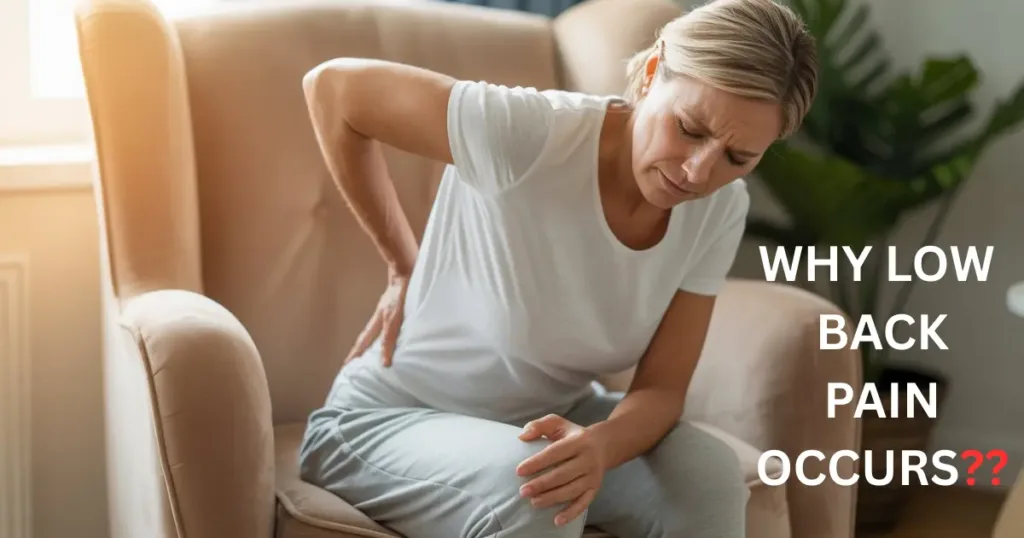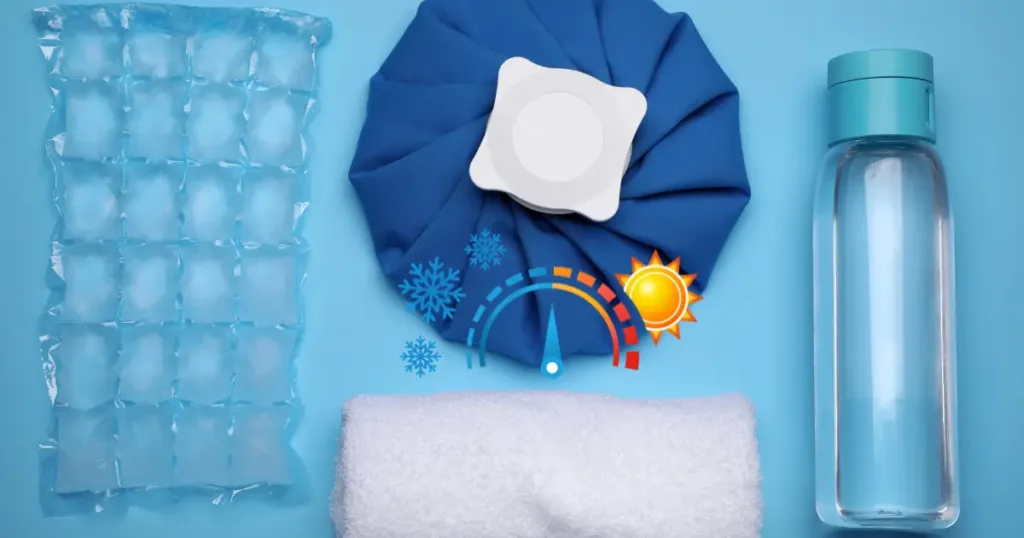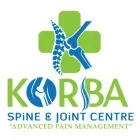If you have asked yourself Why Low Back Pain Occurs, you are not alone. Low back pain is one of the most common reasons people miss work, skip workouts, or wake up feeling older than they are. It affects busy parents, desk workers, long-distance drivers, students, and athletes. The tricky part is that “low back pain” is a single phrase that can come from many different sources. Once you understand those sources, you can choose better fixes and prevent repeat episodes.
In this guide, we will unpack Why Low Back Pain Occurs in plain language. We will cover the seven most common causes, simple screening tips you can use at home, when to see a doctor, practical home remedies used widely, and prevention that actually fits into real life. I will reference trusted medical sources and share what tends to work in clinic and at home.
Table of Contents

The basics: a quick tour of your lower back
A little anatomy goes a long way when you want to know Why Low Back Pain Occurs. Your lumbar spine has five bones stacked like blocks. Between them sit discs that act like shock absorbers. Facet joints guide movement. Strong layers of muscles and ligaments support the stack. Nerves pass through canals and openings to carry messages down the legs.
Pain starts when any one of these parts is irritated. That irritation might come from a strained muscle, a disc that is pushing on a nerve, a stiff arthritic joint, or even a mix of small things that add up, such as too much sitting, weak core muscles, or poor lifting habits. Keeping this blueprint in mind makes it easier to spot Why Low Back Pain Occurs for you.
The 7 most common reasons Why Low Back Pain Occurs
1) Muscle strain or ligament sprain
This is the number-one answer to Why Low Back Pain Occurs, after a weekend of housework, a heavy gym day, or an awkward twist while getting out of a car. Tiny fibers in muscle or ligament overstretch, which triggers soreness and protective spasm. The pain is usually sharp at first, then stiff and achy for a few days. Light walking, brief periods of rest, and slowly easing back into normal activity usually help the most in this stage.
How to spot it: pain is close to the spine or off to one side, it hurts to bend, and it eases with light movement and heat after the first 24 to 48 hours.
2) Poor posture and too much sitting
Sit a lot? That might explain why low back pain occurs, your hips get tight, your core switches off, and your lumbar spine slumps. That kind of posture puts pressure on both the discs and the small joints in your spine. With time, the back muscles end up doing extra work just to keep you upright. The solution is simple: spend more time standing, use proper support when you sit, and strengthen your core muscles.
How to spot it: pain builds across the day, especially after long meetings or driving, and it improves when you stand, walk, or lie down.
3) A herniated or bulging disc
A disc pressing on a nearby nerve can explain why low back pain occurs. The pain can travel into the buttock or down the leg, sometimes with tingling or numbness. Coughing or sneezing can make it worse. Most disc problems settle with time, good activity guidelines, and specific exercises. Imaging is not always needed unless you have red flags, which we will cover below.
How to spot it: clear leg pain below the knee, worse with sitting, better when lying on your back with knees supported.
4) Degenerative disc changes with age

Discs lose water and height as we get older. That is normal. It explains Why Low Back Pain Occurs a little more often after age 40 or 50. Degeneration does not always equal pain, and many people with “worn” discs feel fine. The goal is to stay strong and mobile so the rest of the system carries load well.
How to spot it: a stiff, tired back that warms up after you start moving, with occasional flare-ups after busy days.
5) Spinal stenosis
Stenosis means the space for nerves has narrowed. It is another reason Why Low Back Pain Occurs in later decades. People often describe back and leg pain or heaviness when walking that eases when they lean forward, like when resting on a shopping cart.
You may notice it if your discomfort eases when you sit down, lean forward, or go uphill, but comes back when you stand straight or head downhill.
6) Arthritis and irritated facet joints
Facet joints can get inflamed or arthritic. When they do, Why Low Back Pain Occurs is tied to twisting and arching. Mornings may be stiff, and you might feel sharp twinges with certain movements. Strengthening and mobility work help a lot, and so does pacing your day.
How to spot it: pain with extension, twisting to look behind you, or after standing still for long periods.
7) Lifestyle load: weight, low activity, smoking, and stress
Daily habits add up. Carrying extra weight loads the spine. Smoking slows blood flow to discs. Low activity weakens support muscles. Stress raises muscle tension. Put together, these explain Why Low Back Pain Occurs even when there is no single “injury day.” Small changes in sleep, steps, and strength often give big returns.
How to spot it: gradual onset without a clear event, worse in busy or stressful weeks, better when routines improve.
When to take back pain seriously
Most flare-ups are not emergencies. That said, there are times when Why Low Back Pain Occurs might relate to a condition that needs urgent care. See a doctor right away if you experience any of these signs:
- New trouble controlling bladder or bowel
- Severe weakness in one or both legs
- Numbness in the groin area
- Fever with back pain, or pain after a significant fall or accident
- Unexplained weight loss with ongoing pain
For a reliable overview of causes and red flags, see the Mayo Clinic page on back pain. It is clear and patient-friendly: https://www.mayoclinic.org/diseases-conditions/back-pain/symptoms-causes/syc-20369906. For deeper background on nerve-related causes and sciatica, the NIH/NINDS fact sheet is helpful: https://www.ninds.nih.gov/health-information/disorders/back-pain.
Including trusted sources like these supports the quality of advice here and keeps our discussion grounded in what is known to work.
How clinicians figure out Why Low Back Pain Occurs
A good evaluation starts with your story. When did it start, what makes it worse, what helps, and where does it travel. Then a movement exam checks how your back, hips, and core behave. Simple tests can often point to muscle strain, disc irritation, or facet joint pain.
Imaging is not always step one. If your symptoms fit a common pattern and there are no red flags, most guidelines suggest trying a few weeks of conservative care first. If pain is severe, persistent, or comes with nerve changes, an MRI may be ordered. Understanding this process explains Why Low Back Pain Occurs from a clinical point of view and keeps you from chasing every scan or supplement you see online.
What helps most in the short term
When you are in a flare, the goal is to calm things down without losing strength. Here is how that often looks when Why Low Back Pain Occurs from a typical strain, disc irritation, or joint overload.
- Relative rest for one to three days. Keep walking a bit instead of bed rest.
- Heat or ice based on what feels better. Many people like ice for the first day, then heat.
- Short-term over-the-counter pain relief if you can take it safely.
- Gentle mobility work two or three times a day.
- Return to light normal tasks as soon as you can.
This early plan reduces pain while keeping your body from getting stiff and weak.
Home remedies used widely in the USA
People often manage a large part of recovery at home. These are common, practical options in the United States. Used well, they can shorten a flare and explain Why Low Back Pain Occurs a little less often in your week.

- Heat and cold
For the first day or two after a new strain, applying ice can help reduce irritation. Once that phase passes, gentle heat often works better to loosen stiff muscles. Keep it on for about 15–20 minutes, place a light cloth between your skin and the pack, and always check your skin afterward. - Over-the-counter medicines
Acetaminophen or NSAIDs like ibuprofen can help for a few days. Use the lowest effective dose and check with your clinician or pharmacist if you have other conditions or take blood thinners. - Topical options
Many Americans use menthol rubs, topical NSAID gel like diclofenac, or 4 to 5 percent lidocaine patches for short-term relief around sore areas. - Gentle yoga or stretching
Cat-cow, child’s pose, hip flexor and hamstring stretches, and a supported spinal twist can reduce stiffness. Move slowly and stay out of sharp pain. - Walking routine
Ten minutes, two or three times a day, is a simple way to keep blood flow up and stiffness down. It also lowers stress, which matters when Why Low Back Pain Occurs during busy weeks. - TENS unit
A small battery device that gives light electrical pulses can reduce pain perception for some people. It’s affordable, easy to buy without a prescription, and generally safe for most people. - Support for sleep
Use a medium-firm mattress if possible. If you sleep on your side, try placing a pillow between your knees. If you prefer sleeping on your back, a pillow under your knees can make it more comfortable. Good sleep makes pain easier to manage. - Weight and nutrition basics
Even a modest drop in weight can lower spinal load. Hydration and a diet rich in fruits, vegetables, and protein support tissue healing. - Stress management
Breathing drills, meditation apps, or short outdoor walks lower muscle tension. This is a quiet but powerful lever in back pain. - Pacing heavy tasks
Break big jobs into chunks. Alternate sitting and standing. If lifting is part of your day, plan extra breaks. This reduces the repeated micro-strains that explain Why Low Back Pain Occurs in ordinary life.
Always use home remedies with common sense.If the pain is strong, not getting better, or you spot any warning signs, reach out to your doctor.
A simple daily plan you can try for two weeks
If you are dealing with a non-serious flare and want a place to start, here is a gentle plan. It is designed for common causes of Why Low Back Pain Occurs like strain, posture overload, or mild disc irritation.
Morning, 10 minutes
- Cat-cow, 8 gentle cycles
- Hamstring stretch with a strap, 30 seconds each side
- Pelvic tilt on your back, 10 slow reps
- Box breathing, 4-4-4-4 pattern for one minute
Midday, 10 minutes
- Brisk walk, 8 to 10 minutes
- Standing hip flexor stretch, 30 seconds each side
- Wall angels, 8 slow reps
Evening, 12 minutes
- Bridge, 2 sets of 10 slow reps
- Side plank on knees, 20 to 30 seconds each side
- Child’s pose, 1 minute
- Heat pack for 15 minutes if it helps you relax
If any movement sharpens your pain, skip it and substitute a gentler option. The idea is steady, gentle practice rather than pushing through pain.
Lifting and desk habits that prevent repeat flares
Small technique changes go a long way in preventing the patterns that explain Why Low Back Pain Occurs again and again.
- At your desk: keep the top of your screen near eye level, hips slightly above knees, feet flat, and lower back supported by a cushion or chair lumbar support. Stand up every 30 to 45 minutes for 1 to 2 minutes.
- When you lift something: hold it close to your body, bend at your hips and knees, keep your core engaged, and try not to twist while moving. If it is too heavy, split the load or ask for help.
- While driving: seat slightly reclined, hips as far back as possible, small lumbar roll, and breaks every 60 to 90 minutes on long trips.
These simple changes reduce the repeated strain that often explains Why Low Back Pain Occurs at work or at home.
How long does recovery take
Time frames vary. For a simple strain, most people feel 50 to 80 percent better in 7 to 14 days. For disc-related pain, the first improvements may appear in 2 to 6 weeks, with steady gains over three months. Stenosis and arthritis respond well to a mix of strength, mobility, and pacing, but they are long-term conditions, so the aim is steady control rather than a one-time “cure.” Knowing these timelines helps you set expectations for Why Low Back Pain Occurs and how it improves.
FAQ: Why Does Low Back Pain Occur
1) Why does low back pain occur after sleeping?
Often it comes from a mattress that is too soft or too firm, awkward sleep posture, or tight hip and back muscles. A medium-firm mattress, a pillow between the knees for side sleepers, or a pillow under the knees for back sleepers usually helps. Try gentle stretches like pelvic tilts or cat-cow before getting out of bed.
2) Why does low back pain occur during exercise or weightlifting?
It usually comes down to poor form, lifting too much weight, or skipping your warm-up. Focus on proper hip hinge technique, keep your core engaged, and reduce the load until your form is solid. Warm-up drills like glute bridges and hip openers make a big difference.
3) Why does low back pain occur in pregnancy?
Pregnancy naturally shifts posture, loosens ligaments, and places extra load on the spine. Gentle walking, safe core and pelvic floor exercises, or a maternity support belt can ease symptoms. Always check with your obstetric provider before starting new routines.
4) Why does low back pain occur in teenagers or young adults?
This age group often develops pain from sports overuse, sitting too long while gaming or studying, or carrying heavy backpacks. Building core strength, using a properly fitted backpack, and taking movement breaks usually solve the problem.
5) Why does low back pain occur with age?
Normal wear-and-tear on discs and joints, lower activity levels, and sometimes extra weight make back pain more common with age. Staying active and maintaining strength acts like daily “nutrition” for your spine.
6) Can stress cause low back pain?
Yes. Stress increases muscle tension and makes the nervous system more sensitive to pain. Breathing exercises, short walks, and good sleep habits help calm the body and reduce flare-ups.
7) Why does low back pain occur after sitting all day?
Sitting for hours shortens hip flexors, weakens core support, and rounds the spine. Break the cycle by standing up every 30–45 minutes, using a lumbar support, and adding quick movement breaks like standing extensions or a brisk walk.
8) Can being overweight cause low back pain?
Extra weight increases the load on the spine, which can trigger or worsen pain. Even a modest weight loss of 5–10 pounds often helps. Pair it with a simple strength plan and you’ll usually feel the difference within weeks.
9) Why does low back pain occur without any injury?
Sometimes pain builds slowly from repeated small stresses, such as long hours sitting, awkward lifting, or even tension from stress. These “accumulation injuries” don’t have one big trigger. Tracking your habits and making small changes often brings relief.
10) How do I know if my low back pain is serious?
It may be serious if you notice red flags: bladder or bowel trouble, sudden or worsening leg weakness, numbness in the saddle area, fever with back pain, or pain after a fall. Seek medical care right away if these appear. Otherwise, most back pain improves within a few weeks of conservative care.
Pulling it all together
We have walked through Why Low Back Pain Occurs from seven common causes to the daily habits that make a bigger difference than most people expect. The big idea is simple. Identify the most likely cause, calm the flare without going still, and build strength and better habits so the next flare is smaller or never arrives.
- For muscle strain, think gentle movement, heat after day one, and a steady return to activity.
- For posture overload, stand more, support your lower back, and train your core.
- For disc irritation, ease sitting time, try positions that open space for the nerve, and build strength.
- For arthritis or stenosis, keep moving, bend and stretch in a controlled way, and pace your day.
- For lifestyle load, make small changes in sleep, weight, and walking. They add up.
Lean on trusted resources when you need a deeper dive. The Mayo Clinic overview on back pain and the NIH/NINDS back pain fact sheet are solid places to start, and they align well with what we covered here.
If you remember one thing from this whole guide, let it be this: Why Low Back Pain Occurs is usually a mix of manageable factors, and most people do very well with steady, smart changes. Your back is built to move. Treat it that way.
Quick self-check plan for the next month
Use this four-step checklist to reduce the patterns that explain Why Low Back Pain Occurs for you.
- Move every hour
Stand, walk, or stretch for 1 to 2 minutes. - Add three core moves
Bridges, side planks on knees, and bird dog, three days a week. - Upgrade one habit
Better sleep setup, ten more minutes of walking, or a weekly yoga class. - Track triggers
Note what makes pain worse or better. Adjust and retest for two weeks.
If you do these four simple things, there is a good chance your next flare will be milder and shorter, and your good days will outnumber the bad ones.
Final note on safety and scope
This article offers education and general strategies. It cannot replace a visit with your clinician, especially if symptoms are severe, persistent, or unusual for you. If in doubt, get checked. It is always worth ruling out the rare, serious causes while you work on the common one,
Further Reading
- Exercise of Low Back Pain: What Works and What to Avoid
- Low Back Pain Near Kidneys? How to Know if It’s a Kidney Problem or Muscle Problem?

Dr. Vivek Arora (BPT, MPT, FRCPT, MIAP) is a licensed physiotherapist with over 20 years of experience in spine and joint care. He specializes in evidence-based physiotherapy, patient education, and long-term recovery without surgery. Passionate about empowering patients through knowledge, Dr. Arora shares expert-backed health content for a global audience.
To know more about Dr. Vivek’s journey, click here.
